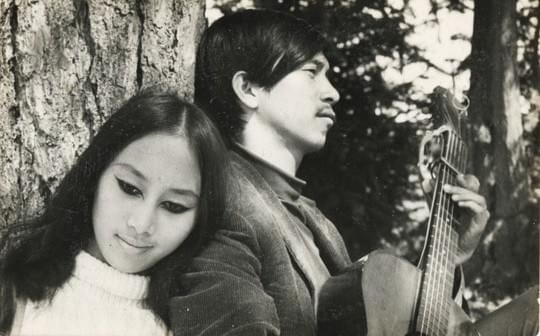
Currently, I notice that the youth are chasing after music genres lacking substance, lyrics devoid of meaning, and both composers and listeners lacking depth.
We are Vietnamese people, yet we lack the soul of Vietnam in our music and lyrics. As I mentioned before, French teachers like Victor François Tardieu (1870-1937) truly cultivated a talented generation of artists in the East Indochina Fine Arts College, similarly to the New Music movement (1928) during the same period. In the era influenced by French waltz and tango, Vietnamese essence permeated through, and a generation of teenagers (13-19 years old) up to young adults (20-21 years old) accomplished marvels beyond what we can imagine in the past 30 years.
Đinh Nhu (1910 – 1945) was born into a poor family making a living selling flowers. He was passionate about theater and music since elementary school. Due to financial difficulties, he had to drop out of school and joined the Revolutionary Youth League of Vietnam in 1927. By the end of 1929, he was imprisoned by the French at “Hilton Hanoi” and sentenced to life in exile on Con Dao Island. While in prison, he taught other inmates to sing, and the song “Cùng nhau đi Hồng binh” was born. This song was inspired by the fervent struggle against the French in the 1930s, especially the Nghe-Tinh Soviet movement (1930–1931). Although not a prominent figure in Vietnamese music history, “Cùng nhau đi Hồng binh” (1930, when he was only 21 years old) left a profound mark, praising the revolutionary forces in the early stages of the anti-French resistance. For me, the song “Cùng nhau đi Hồng binh” adds strength and spirit to the soldiers and people in the struggle for freedom and independence. Đinh Nhu’s first composition was also the first song of the New Music movement.
Also composing his first piece at the age of 21, we have musician Hoàng Giác (1924-2017) from Chèm village, Hanoi. His father was a skilled gourd zither player but was passionate about boxing, even serving as the President of the North Vietnam Boxing Federation. Hoàng Giác himself was also passionate about sports. He attended Buoi School (now Chu Van An) where he studied music through French composition and harmony materials. In 1945, at the age of 21, he wrote his first song “Mơ hoa,” marking a significant change in Vietnam with the success of the August Revolution. The messages of romantic longing, encountered by a young couple in life’s journey, expressing dreams and aspirations for a peaceful world, love, and beautiful life, reflect hope and dreams for a brighter future after achieving independence.
Poet – musician Nguyễn Đình Thi (1924-2003) was born in Luang Prabang, Laos, but his ancestral village is in Vũ Thạch village, Hanoi. His father was a civil servant in the Indochina Postal Department who worked in Laos. In the 1940s, he joined the National Salvation Cultural Group during the Japanese occupation of Indochina. In 1945, he participated in the Tan Trao National Congress and was elected as a delegate to the first National Assembly of Vietnam. At the same time, he, Văn Cao, and Đỗ Nhuận each wrote a revolutionary song in response to the movement’s demands. Thus, when the poet – musician was only 21 years old, the song “Diệt phát xít” was born, although it was not published in the Independent Newspaper and was only distributed in manuscript form. After the August Revolution, Nguyễn Đình Thi became the Secretary-General of the National Salvation Cultural Group. The song “Diệt phát xít” expresses the determination and strength of the people in the fight against fascist ideologies and serves as a call for unity and determination of the Vietnamese people during wartime.
Musician Ngô Hoàng Dương (1933-2017) was the son of the renowned cultural figure Ngô Văn Triện (pen name Trúc Khê). He was also a talented cello player and played a key role in establishing the cello department at the Hanoi Conservatory of Music. After the Geneva Accords in 1954, he encouraged intellectuals and artists not to migrate to the South following the call of the National Government of Vietnam. During a secret mission, he was discovered and had to flee to the outskirts. There, he met a young woman and they went to Hồ Tây, Hồ Trúc Bạch to watch the sunset together, but later lost contact. He made several trips to the South to find her but with no success, so he poured his emotions into the song “Hướng về Hà Nội” (Turning towards Hanoi) expressing deep longing and nostalgia. The song was composed against the backdrop of Hanoi – the heart of the nation – during the struggle against the French, evoking the image of Hanoi during difficult but resilient times, inspiring deep patriotism. Evaluated as a “masterpiece of music about Hanoi,” this first composition was born when the author was 21 years old.
Musician Trần Hoàn (1928-2003), whose real name is Nguyễn Tăng Hích, was from Hải Lăng, Quảng Trị. His father was a music enthusiast with a strong interest in Huế music, classical opera, Western music, which influenced his musical career later on. In 1935, Trần Hoàn studied at the Quốc học Huế. He self-taught music composition from the age of 16-17. At the age of 20, he composed the song “Sơn nữ ca” while in the combat zone of Quảng Bình. “Sơn nữ ca” praises the strength reflecting the life, spirit, courage, and authentic beauty of the women in the highlands and minority women in the mountainous regions during the resistance against the French.
Everyone knows Trịnh Công Sơn (1939-2001) as one of the greatest musicians of Vietnam with deeply humanistic songs, dubbed by the American press as the “Bob Dylan of Vietnam.” His family hailed from Thừa Thiên Huế but settled in Đắk Lắk before returning to business in Huế. Before 1958, his mother owned a large store on Phan Bội Châu Street, but due to losses, they had to close it and focus on providing for their children’s education at home. At the age of 19, he met singer Thanh Thúy and composed the songs “Ướt mi” and “Thương một người” as gifts when he went to watch her perform at the Mỹ Cảnh restaurant. Both songs reflect Trịnh Công Sơn’s profound thoughts and emotions about fragile first love and deeply sentimental life, expressing sadness and regret in love through poignant lyrics and gentle, profound melodies.
A young and talented musician who blossomed earlier than Trịnh was Lê Minh Lập (1941-1999) from Đà Lạt. His family originally bore the surname Phan, but due to Phan Bội Châu’s revolution, they changed it to Lê. His mother was Công Tôn Nữ Phương Nhi, the ninth daughter of King Thành Thái. Due to lost documents, he had to re-register his birth certificate twice. He adopted the stage name Lê Uyên Phương from his mother’s name, Phương, and his first girlfriend’s name, Uyên. In 1960, at just 19 years old, he composed his debut song “Buồn đến bao giờ” in Pleiku, a confessional piece where the narrator questions and seeks answers to his lingering sadness. The melancholic melody and profound lyrics of the song reflect the introspection and quest for answers in the heart of a young person facing life’s challenges and relationships. This song not only tells a personal story but also voices the sentiments of many young people in Vietnamese society at the time, grappling with significant changes in society and life.
Musician Ngô Thụy Miên, born in 1948 in Hải Phòng, was the second child in a family of seven. He grew up surrounded by books and literature because his family owned a bookstore named Thanh Bình in Hải Phòng, later relocated to Nguyễn Đình Chiểu Street when they settled in Saigon. In 1963, he started composing music and completed his first love song, “Chiều nay không có em,” two years later, which received enthusiastic responses from students. The song was written during the Vietnam War era, a melancholic confession of those left behind, expressing through its gentle yet emotional melody the feelings of separation and longing. It’s worth remembering that, at that time, the young author was only 17 years old.
Lastly, the “king” of young, sentimental musicians was Cung Tiến (1938-2022). What’s particularly remarkable is that his first love song was composed at the age of 14-15, when he left behind his childhood memories to embark on a long, exhausting journey from North to South, to a completely unfamiliar city. Everything – from the streets, people, language, food, clothing, lifestyle, habits – felt strange. The sudden cultural shock created a cultural “shock” that he couldn’t define or name. The emotions in the soul of the 15-year-old boy, with boundless imagination, condensed into an unparalleled masterpiece, “Hoài Cảm,” about nostalgia for loved ones, longing for the classical homeland, refined and profound, reaching the depths of emotion as if 50 years of separation had passed. As the author reminisced, “I left early, meaning from Hanoi to Saigon early. When leaving, I remembered everything that Hanoi engraved in my memory, it’s like having that piece of music.” And thus, the iconic masterpiece “Chiều buồn len lén tâm tư” was born when the author was only … 15 years old.
Every time the masterpieces of those young days resound – romantic, grand, profound, and timeless – I suddenly realize that I’m older than all the East Indochina Fine Arts College and New Music pioneers back then. Vietnam’s youth once had vibrant springs, radiant summers, classic autumns, and profound winters like that.
Perhaps our budding youth have the potential to achieve even more. Let’s focus on honing skills, emotions, and thoughts to contribute enduring works and masterpieces to the world.
Related
Source: Vietnam Insider
